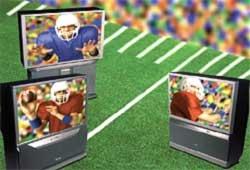Are You Ready for Some HDTV?

Coach Lou Holtz was having a tough day. By the middle of the third quarter, he'd pushed his South Carolina team to a precariously slim 7-3 lead over Arkansas, only to see the Razorbacks reverse the advantage with a few minutes remaining on the clock. As Holtz's team futilely hammered away in the fourth, the crags on his face deepened, exasperation steaming out at each bungled opportunity to score.
With my close perspective on his explosive reactions, I could feel Holtz's tension. Where was my seat for this grueling college football matchup? Not on the South Carolina bench but the next best spot: parked in front of a big hulking HDTV - three of them, to be exact, stretched out before me like a defensive line. Along with football, each autumn brings a new fleet of TV sets. And what better chance to test the capabilities of freshly minted HDTV monitors than a high-definition broadcast of NCAA college football action?
If you've been seriously thinking of buying a big-screen HDTV, now might be the right time. Prices have dropped, and performance has reached new highs, making a big-screen TV an enticing purchase. Adding to the appeal is a new infusion of high-definition programming on broadcast and satellite channels. ABC recently matched CBS in delivering most of its prime-time lineup in high-def, while NBC began airing the popular Crossing Jordan series, which now joins The Tonight Show on its high-def schedule. On the satellite side, DirecTV introduced HDNet, a sports-oriented all-high-def channel featuring major league baseball and NHL hockey games. So if a lack of high-def programming was your rationale for waiting to buy an HDTV, you'll need to find yourself a new one!
HDTV images come in an eyeball-stretching 16:9 aspect ratio, which is considerably wider than regular TV pictures. That makes HDTV the perfect medium for sports, where a panoramic view lets you see more of the action as it unfolds on the field, court, or rink. Although some high-def sets come with standard 4:3 screens, we compared only widescreen rear-projection TVs (RPTVs) because they deliver the most dramatic HDTV images. We also selected models whose screens measure 50 to 53 inches (diagonal) because they generally offer the biggest bang for the buck. Of course, since all three sets in our comparison are HDTV monitors, we used outboard HDTV tuners to feed high-def signals to them. So how did they fare? Let's go to the playback.
- Log in or register to post comments














































